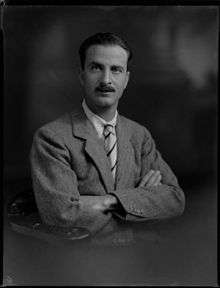Michael Knatchbull, 5th Baron Brabourne
| His Excellency The Right Honourable The Lord Brabourne GCSI GCIE MC | |
|---|---|
 Michael Knatchbull in 1929 | |
| Member of Parliament for Ashford | |
|
In office 27 October 1931 – 17 March 1933 | |
| Preceded by | Roderick Kedward |
| Succeeded by | Sir Patrick Spens |
| Governor of Bombay | |
|
In office 1933–1937 | |
| Preceded by | Sir Frederick Sykes |
| Succeeded by | Sir Lawrence Lumley |
| Governor of Bengal | |
|
In office 1937–1939 | |
| Preceded by | Sir John Anderson |
| Succeeded by | John Arthur Herbert |
| Personal details | |
| Born | 8 May 1895 |
| Died | 23 February 1939 (aged 43) |
| Spouse(s) | Lady Doreen Browne |
Michael Herbert Rudolf Knatchbull, 5th Baron Brabourne GCSI GCIE MC (8 May 1895 – 23 February 1939) was a British peer and soldier, the son of the 4th Baron Brabourne.
Early life
Baptised Michael Herbert Rudolf Knatchbull-Hugessen, he dropped the Hugessen part of his surname by deed poll in 1919.[1] Knatchbull was educated at Wellington College and the Royal Military Academy, Woolwich.
Military career
He served in the Royal Artillery, rising to the rank of Lieutenant and in the RAF, rising to Captain. He fought in the First World War (where he was mentioned in dispatches three times) and was awarded the Military Cross.
House of Commons
Knatchbull was elected Conservative Member of Parliament (MP) for Ashford in 1931 and served as Parliamentary Private Secretary to Samuel Hoare, Secretary of State for India, from 1932 to 1933.
House of Lords
In 1933, upon his father's death, he succeeded as Baron Brabourne following which he was made Governor of Bombay and was invested as a Knight Grand Commander of the Order of the Indian Empire.[2]
Governor of Bombay
While Governor of Bombay he laid the foundation stone at the historic Brabourne Stadium cricket ground in 1936 after conducting negotiations for the land with Anthony de Mello of the Cricket Club of India (CCI).
Governor of Bengal
In 1937 he also became a Knight Grand Commander of the Order of the Star of India[3] and served as Governor of Bengal until 1939, the year he died.
Family
On 22 January 1919, he married Lady Doreen Browne, daughter of the 6th Marquess of Sligo and they had two children:
- Norton Cecil Michael Knatchbull, 6th Baron Brabourne (1922–1943)
- John Ulick Knatchbull, 7th Baron Brabourne (1924–2005). In 1946 he married The Hon. Patricia Mountbatten (later 2nd Countess Mountbatten of Burma) and had issue.
His widow, The Dowager Lady Brabourne, was murdered in the 1979 bombing by the Provisional Irish Republican Army bombing of Louis Mountbatten, 1st Earl Mountbatten of Burma's boat. One of their grandsons also died in the bombing.
Styles of address
- 1895-1915: Mr Michael Knatchbull-Hugessen
- 1915-1919: The Honourable Michael Knatchbull-Hugessen
- 1919-1931: The Honourable Michael Knatchbull
- 1931-1933: The Honourable Michael Knatchbull MP
- 1933: The Right Honourable The Lord Brabourne[lower-alpha 1]
- 1933-1937: His Excellency The Right Honourable The Lord Brabourne GCIE
- 1937-1939: His Excellency The Right Honourable The Lord Brabourne GCSI GCIE
References
- ↑ The London Gazette: no. 31495. p. 10145. 8 August 1919.
- ↑ The London Gazette: no. 33993. p. 7187. 7 November 1933.
- ↑ The London Gazette: no. 34451. p. 6889. 5 November 1937.
- Lundy, Darryl. "ThePeerage.com His details & photo". The Peerage].
- Leigh Rayment's Peerage Pages
- Leigh Rayment's Historical List of MPs
External links
- Hansard 1803–2005: contributions in Parliament by Lord Brabourne
| Parliament of the United Kingdom | ||
|---|---|---|
| Preceded by Roderick Kedward |
Member of Parliament for Ashford 1931–1933 |
Succeeded by Sir Patrick Spens |
| Political offices | ||
| Preceded by Sir Frederick Sykes |
Governor of Bombay 1933–1937 |
Succeeded by Sir Lawrence Lumley |
| Preceded by Sir John Anderson |
Governor of Bengal 1937–1939 |
Succeeded by John Arthur Herbert |
| Peerage of the United Kingdom | ||
| Preceded by Cecil Knatchbull-Hugessen |
Baron Brabourne 1933–1939 |
Succeeded by Norton Knatchbull |